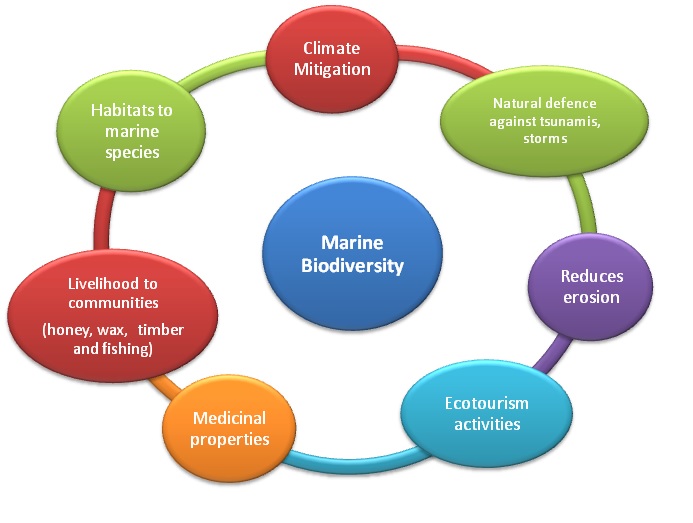Biodiversity refers to the diversity of all life forms and at all levels of organization. The levels of biodiversity are the diversity within a species (genetic diversity), the diversity of species (species diversity) and the diversity of ecosystems (habitat or ecosystem diversity). Talking about the Marine Biodiversity, Oceans and major seas cover 70% of the earth and 50% of all species on Earth (under the ocean).
India has a vast coastline of 7, 517 km and an Economic Exclusive Zone of 2.02 million sq. km. There are several types of coastal ecosystems in India namely inland freshwater wetlands, inland brackish water wetlands, estuarine wetlands, coastal mudflats, sand dunes, rocky shores, mangrove forests and coral reefs. This coastline supports human population that is dependent on the rich coastal and marine resources.
It is estimated that nearly 250 million people live within a swath of 50 km from the coastline of India. The ecological services of marine and coastal ecosystems of India play a vital role in India’s economic growth (Convention on Biological Diversity, https://www.cbd.int). As per the literature, a wide range of ecosystem services are provided by marine resources such as food supply, regulation of water-quality processes, storm protection, and carbon storage. The marine ecosystems play a critical role in global climate and the carbon cycle through the process of carbon sequestration. By supporting recreational activities and providing aesthetic beauty, coastal ecosystems also contribute to the well-being of both coastal and inland inhabitants. They are the primary producers of fish, shellfish, and seaweed for both human and animal consumption. In addition they are also a considerable source of fertilizer, pharmaceuticals, cosmetics and construction materials. The potential yield of marine fisheries resources in the Indian Exclusive Economic Zone is estimated as 5.31 Million Metric Tonnes in 2018 and the current levels of fish production is 3.71 Million Metric Tonnes (Report of Ministry Of Fisheries, Animal Husbandry And Dairying, 2018).
GULF OF MANNAR MARINE BIOSPHERE RESERVE
The Gulf of Mannar Marine Biosphere Reserve is the first marine Biosphere Reserve of India. It was established in 1989 endowed with three distinct Coastal ecosystems namely coral reef, seagrass bed and mangroves. The marine reserve extends from Rameswaram island in the North to Kanyakumari in the South of Tamil Nadu, which encompasses a chain of 21 islands. The adjoining coral reefs off the coasts of the Ramanathapuram and the Tuticorin districts forms the core zone of the marine biosphere reserve (ENVIS, Government of Tamil Nadu). It is considered as one of the world’s richest region from a marine biodiversity perspective.
The Gulf of Mannar has around 4000 species of plants and animals representing from primitive to higher forms make it one of the richest coastal regions in India. The islands have luxuriant growth of mangroves on their shorelines and swampy regions. The sea bottom of the inshore area are carpeted with seagrass beds which serve as ideal feeding ground for Dugong dugon, the endangered herbivorous marine mammal. Seagrass beds serve as nursery and spawning grounds for diverse biota. This habitat is the feeding grounds for the Dugong and sea turtles (UNESCO, https://en.unesco.org/biosphere/aspac/gulf-mannar).
Management aspects:
It has been estimated by various studies that humans have already altered 75% of land surface and 40% of marine environment which has lead to increased ecosystem vulnerability to invasion by non-native species. Numerous direct and indirect pressures arising from different types of economic development are having adverse impacts on coastal and marine biodiversity across the country. Further, climate change is likely to have an impact on coastal and marine ecosystems (like sea level rise, warming of the sea surface temperatures and ocean acidification). Habitat destruction; over-harvesting of marine resources; and potential localized land based marine pollution from civic point-sources have been reported to be the primary threats to this globally significant marine reserve.
Ministry of Environment Forest and Climate Change enacts the Environment (Protection) Act, 1986, Coastal Regulation Zone (CRZ) Notification, 1991 and National Biodiversity Act, 2002 for conservation of coastal and marine environment. Marine Ecosystems have been declared as ecologically sensitive areas under the Environment (Protection) Act, 1986. Comprehensive management of the coastal areas of the country is provided through the Coastal Zone Management Plans in accordance with the provisions and regulations of the CRZ Notification. The activities of coastal zone management plan includes mangrove plantation, Construction of Multipurpose Cyclone Shelters, Development of tourism infrastructure and sustainable livelihood options for fishermen community, Livelihood security through establishment of Self Help Groups, Coir based products as alternate livelihood options to fishermen/ women.
Further mass awareness on conservation of coastal environment among the public is the need of hour in order to achieve Sustainable Development Goal-14: life below water to conserve and sustainably use the oceans, seas and marine resources for sustainable development.
.International agreements/conventions relating to conservation of marine biodiversity:
|
S.No. |
Name |
|
|
Convention on Biological Diversity |
|
|
Ramsar Convention on Wetlands |
|
|
UNESCO Man and Biosphere Programme |
|
|
Convention on Migratory Species |
|
|
Convention on the International Trade of Endangered Species |
|
|
United Nations Framework Convention on Climate Change and the Kyoto Protocol |
